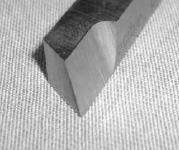- Joined
- Mar 17, 2018
- Messages
- 1,400
What mikey said and use your tailstock. A file with a handle different grits of emery cloth and some scotchbrite can work wonders when needed.

I learned something new today!Have a look on the web for details of a shear tool. Dead simple to grind (only 2 faces to grind). Only takes off a few thou at once but you can use one to get a much nicer finish on a lot a steels that wouldn't behave otherwise. I use one quite often to tidy up EN8 (medium carbon - not easy to make it shine!).
Rob
Re aluminum or brass. I got a handy pdf from steves-workshop.co.uk that walked me through the process of grinding a tool. However, it says that steel, brass and aluminum all need very different side and back rack. Eg 0 back rake for brass, 15 degrees for steel and 35 degrees for aluminum. (Suddenly, I see a LOT of grinding in my future.) I really need different bits for each of these metals?
Craig
